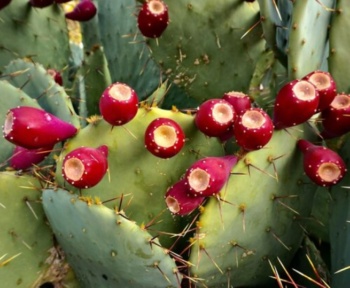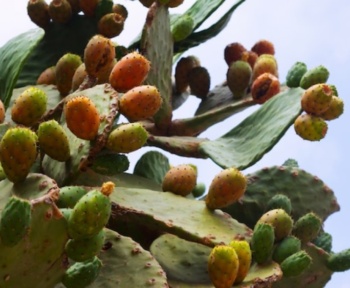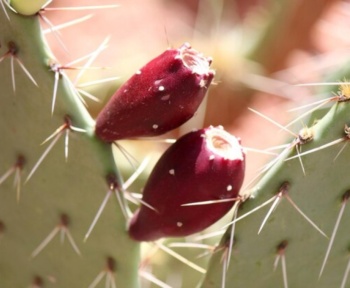Introduction
Prickly pear cactus is one of those hidden gems in the food world. If you’ve never tried it, you’re in for a treat—sweet, tangy, and full of health benefits. If you’ve seen these vibrant fruits or their flat, green pads in the store, you might wonder how to prepare them. Well, don’t worry; we’re about to take you through everything you need to know to get the most out of prickly pear cactus. We’ve covered you, from prep tips to creative ways to cook with it.
What is Prickly Pear Cactus?
Prickly pear cactus is a plant that grows in desert-like areas—think the Southwest U.S. and parts of Mexico. It’s been around for centuries and has been used in various ways. The plant has two edible parts: the sweet, fruity flesh (tunas) and the slightly tangy, savory pads (nopales). Both are packed with nutrients and can be used in various dishes, whether you’re craving something sweet or savory. Let’s dive into each one.
Prickly Pear Fruit (Tunas)
The fruit of the prickly pear cactus is what most people know and love. It’s small, vibrant, and packed with natural sweetness. The flesh is juicy with tiny seeds you can munch on or strain out, depending on your preference. If you’ve never had it before, think of it as a cross between watermelon and kiwi in terms of texture and flavor—delicious! The fruit can be eaten raw, made into juice, or added to desserts.

Prickly Pear Pads (Nopales)
Now, the pads—also called nopales—are a bit of a different story. They’re flat, green, and have a savory, almost citrus-like taste. Many people use these in Mexican cooking, whether grilled, sautéed, or even tossed raw into salads. The pads have a tender texture and a slightly chewy bite when cooked. Think of them as a veggie but with a unique twist.
Health Benefits of Prickly Pear Cactus
It’s not just about the taste, either. Prickly pear cactus is packed with vitamins, fiber, and antioxidants, making it a great addition to a healthy diet. Here’s why you should start incorporating it into your meals.
Packed with Vitamins and Fiber
Both the fruit and the pads are super nutritious. The fruit is rich in vitamin C, which can help boost your immune system, while the pads are full of fiber, which keeps your digestive system running smoothly. Plus, both parts contain antioxidants, which are great for fighting off free radicals in the body.

Good for Digestion
If you’re dealing with digestive issues, prickly pear cactus could be just what you need. The fiber in both the fruit and pads can help with regularity, prevent constipation, and keep your gut in check.
Helps with Skin Health
Prickly pear cactus doesn’t just do wonders for your insides—it’s great for your skin, too! Its antioxidants help reduce inflammation and protect your skin from damage, keeping it looking fresh and youthful.
May Help Regulate Blood Sugar
Prickly pear cactus is an excellent option for managing blood sugar levels. Studies suggest that it can help regulate blood sugar, essential for people with diabetes or anyone looking to maintain healthy levels.

How to Prepare Prickly Pear Cactus Fruit and Pads
Preparing prickly pear cactus doesn’t have to be intimidating—it’s pretty simple once you know what to do. Here’s how to get started.
Choosing Prickly Pear Cactus
When shopping for prickly pear cactus, look for firm fruit but not too hard. You want it to be ripe but not overripe. For the pads, look for fresh, green ones with no signs of browning or wilting.
Removing the Spines
Here’s the tricky part: removing the spines. Whether it’s the fruit or the pads, both have tiny spines that can be a pain to handle. The fruit is usually covered with small, needle-like spines, while the pads might have bigger ones. The easiest way to deal with them is using tongs or gloves. For the pads, you can also use a vegetable peeler or knife to scrape off the spines.

Preparing the Fruit
- Cut the Ends: Slice off both ends of the prickly pear fruit to give you a flat surface.
- Peel the Skin: Make a small slit along the fruit’s length and peel back the skin. The flesh inside is soft, juicy, and ready to eat!
Preparing the Pads
- Clean the Pads: Wash them thoroughly under running water.
- Slice the Pads: Cut the pads into strips or cubes, depending on how you want to use them. The texture is versatile, so you can customize it to your dish.
Best Ways to Use Prickly Pear Cactus Fruit and Pads
Once you’ve prepped your prickly pear cactus, the fun part begins—cooking with it! Here are some of the best ways to enjoy the fruit and its pads.
Smoothies and Juices
The fruit is perfect for smoothies. Blend it with other fruits like mango, banana, or berries for a sweet, refreshing drink. Or, if you prefer something a little more grown-up, try making prickly pear juice. Blend the fruit, strain out the seeds, and get a healthy, delicious drink.
Tacos and Salads
The pads shine in savory dishes. You can grill, sauté, or even eat them raw in salads. A classic way to prepare them is by sautéing them with onions, garlic, and tomatoes, then tossing them in a taco. It’s a fresh, flavorful way to add variety to your meals.
Prickly Pear Jam and Syrup
If you want something sweet, prickly pear fruit makes a delicious jam or syrup. To make the jam, cook the fruit with sugar and a little lemon juice until it thickens. Spread it on toast or use it as a topping for pancakes.
Stir-Fry and Sautéed Dishes
Nopales work great in stir-fries. Toss them in with other veggies and a protein like chicken or shrimp for a quick, healthy meal—the savory flavor pairs well with lime and other seasonings.

Common Mistakes to Avoid
When cooking with prickly pear cactus, a few things can trip you up. Here are some common mistakes to avoid.
Not Removing the Spines Properly
Remove all the spines before cooking with the fruit or pads. Even tiny ones can irritate your skin. Gloves or tongs will make this process much more manageable.

Cutting the Pads Too Thin
When slicing the pads, don’t go too thin. Once cooked, thin slices can become too chewy and tough. Go for thicker cuts for the best texture.
Overcooking the Pads
Nopales cook quickly, so keep an eye on them to avoid overcooking. They should be tender but still have a little bite.
Checklist for Preparing Prickly Pear
- Wear gloves or use tongs to handle the fruit and pads.
- Slice off both ends of the fruit before peeling.
- Cut the pads into thicker slices for better texture.
- Keep it simple—try sautéing, grilling, or blending for the best results.
Interview Highlight: Exploring the Versatility of Prickly Pear Cactus
“The more I work with prickly pear cactus, the more I realize how much it brings to the table—flavor, nutrition, and creativity in the kitchen,”
says chef Maria Delgado. Her love for using cactus in traditional and modern recipes shows why this ingredient is becoming so popular.
Conclusion
Prickly pear cactus is more than just a quirky, spiky plant—it’s a nutrient-packed superfood that can be used in various delicious ways. The fruit and pads offer endless possibilities, whether you’re making smoothies, tacos, or jams. Don’t worry; it’s not as complicated to prepare as it might seem—follow a few simple steps, and you’re good to go. Give it a try, and you might find yourself adding prickly pear cactus to your regular rotation of ingredients!
FAQs
Prickly pears cactus contains nutrients like antioxidants, vitamins, and fiber. It can help digestion, support the immune system, and even balance blood sugar. It’s also great for your skin because it reduces swelling.
Always wear gloves or use tongs to handle the cactus. For the fruit, cut off the ends, make a small cut in the skin, and peel it away. Scrape the spines with a vegetable peeler or knife for the pads.
It’s getting much attention for its health benefits and unique taste. People are using it in smoothies, salads, and even gourmet meals. It’s especially loved by those who want to try new healthy foods.
Yes! Once you remove the spines and skin, the fruit and pads are ready to eat raw. However, many people prefer to cook them by grilling, sautéing, or pickling.
Look for it in specialty grocery stores, farmers’ markets, or online. In the UK, try organic or ethnic markets. In the USA, check stores focused on Mexican or Southwest foods.





